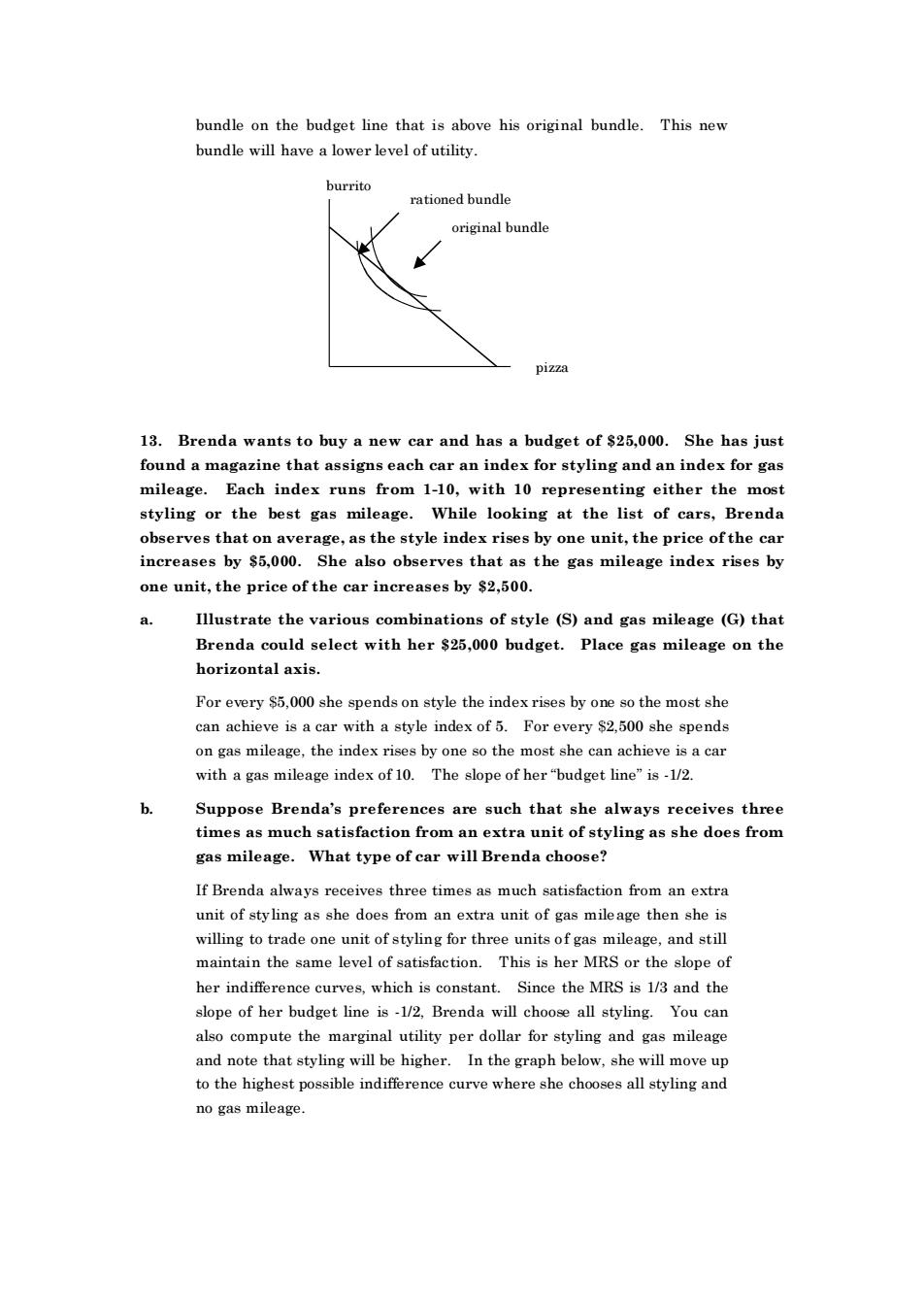正在加载图片...

bundle on the budget line that is above his original bundle.This new bundle will have a lower level of utility. urrito rationed bundle original bundle pizza 13.Brenda wants to buy a new car and has a budget of $25,000. She has just found a magazine that assigns each car an index for styling and an index for gas mileage.Each index runs from 1-10,with 10 representing either the most styling or the best gas mileage.While looking at the list of cars,Brenda observes that on aver inereases by $5000. age,as the style index rises by one unit,the price of the She also observes that as the gas milea one unit,the price of the car increases by $2,500 Illustrate the various combinations of style (S)and gas mileage (G)that Brenda could select with her $25,000 budget.Place gas mileage on the horizontal axis. For every $5,000 she spends on style the index rises by one so the most she can achieve is a car with a style index of 5.For every500 she spends on gas mileage,the index ri by one so the most she ca achieve is sa ca with a gas mileage index of 10 The slope of her"budget line"is-1/2 b. Suppose Brenda's preferences are such that she always receives three times as much satisfaction from an extra unit of styling as she does from gas mileage.What type of car will Brenda choose? If Brenda always receives three times as much satisfaction from an extra unit of styling as she does from an extra unit of gas mileage then she is willing to ade unit of styling for mintin the same lovel of tion.Th ber NRsthe slopo of thre oI g and st her indifference curves,which is constant.Since the MRS is 1/3 and the slope of her budget line is-1/2,Brenda will choose all styling.You can also compute the marginal utility per dollar for styling and gas mileage and note that sty will be higher. In the graph below w,she will move u to the highe est possible e indifference curve where she chooses all styling an no gas mileage. bundle on the budget line that is above his original bundle. This new bundle will have a lower level of utility. original bundle burrito pizza rationed bundle 13. Brenda wants to buy a new car and has a budget of $25,000. She has just found a magazine that assigns each car an index for styling and an index for gas mileage. Each index runs from 1-10, with 10 representing either the most styling or the best gas mileage. While looking at the list of cars, Brenda observes that on average, as the style index rises by one unit, the price of the car increases by $5,000. She also observes that as the gas mileage index rises by one unit, the price of the car increases by $2,500. a. Illustrate the various combinations of style (S) and gas mileage (G) that Brenda could select with her $25,000 budget. Place gas mileage on the horizontal axis. For every $5,000 she spends on style the index rises by one so the most she can achieve is a car with a style index of 5. For every $2,500 she spends on gas mileage, the index rises by one so the most she can achieve is a car with a gas mileage index of 10. The slope of her “budget line” is -1/2. b. Suppose Brenda’s preferences are such that she always receives three times as much satisfaction from an extra unit of styling as she does from gas mileage. What type of car will Brenda choose? If Brenda always receives three times as much satisfaction from an extra unit of styling as she does from an extra unit of gas mileage then she is willing to trade one unit of styling for three units of gas mileage, and still maintain the same level of satisfaction. This is her MRS or the slope of her indifference curves, which is constant. Since the MRS is 1/3 and the slope of her budget line is -1/2, Brenda will choose all styling. You can also compute the marginal utility per dollar for styling and gas mileage and note that styling will be higher. In the graph below, she will move up to the highest possible indifference curve where she chooses all styling and no gas mileage